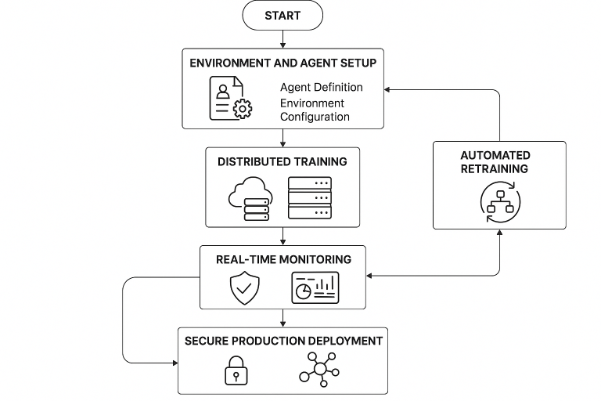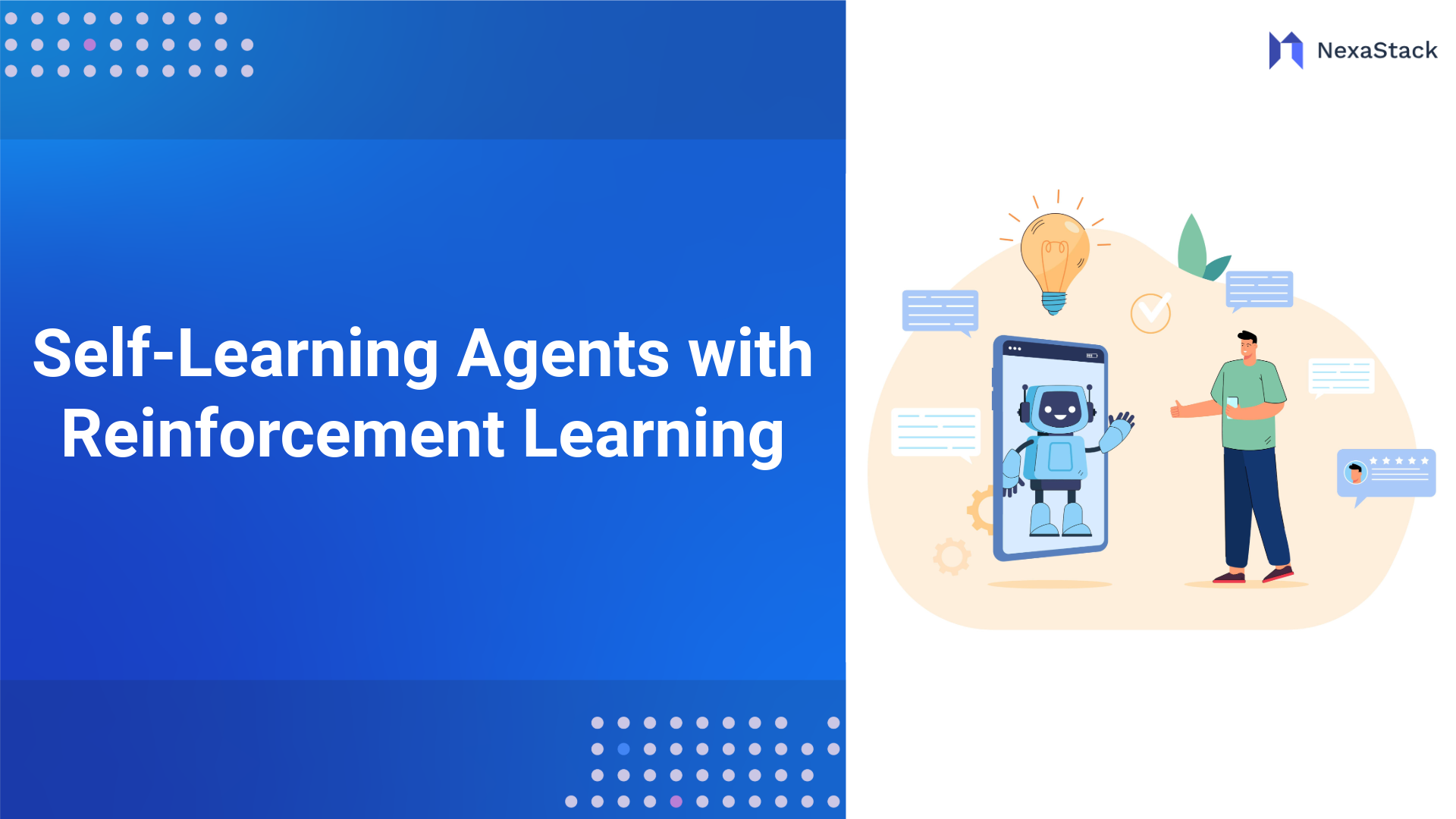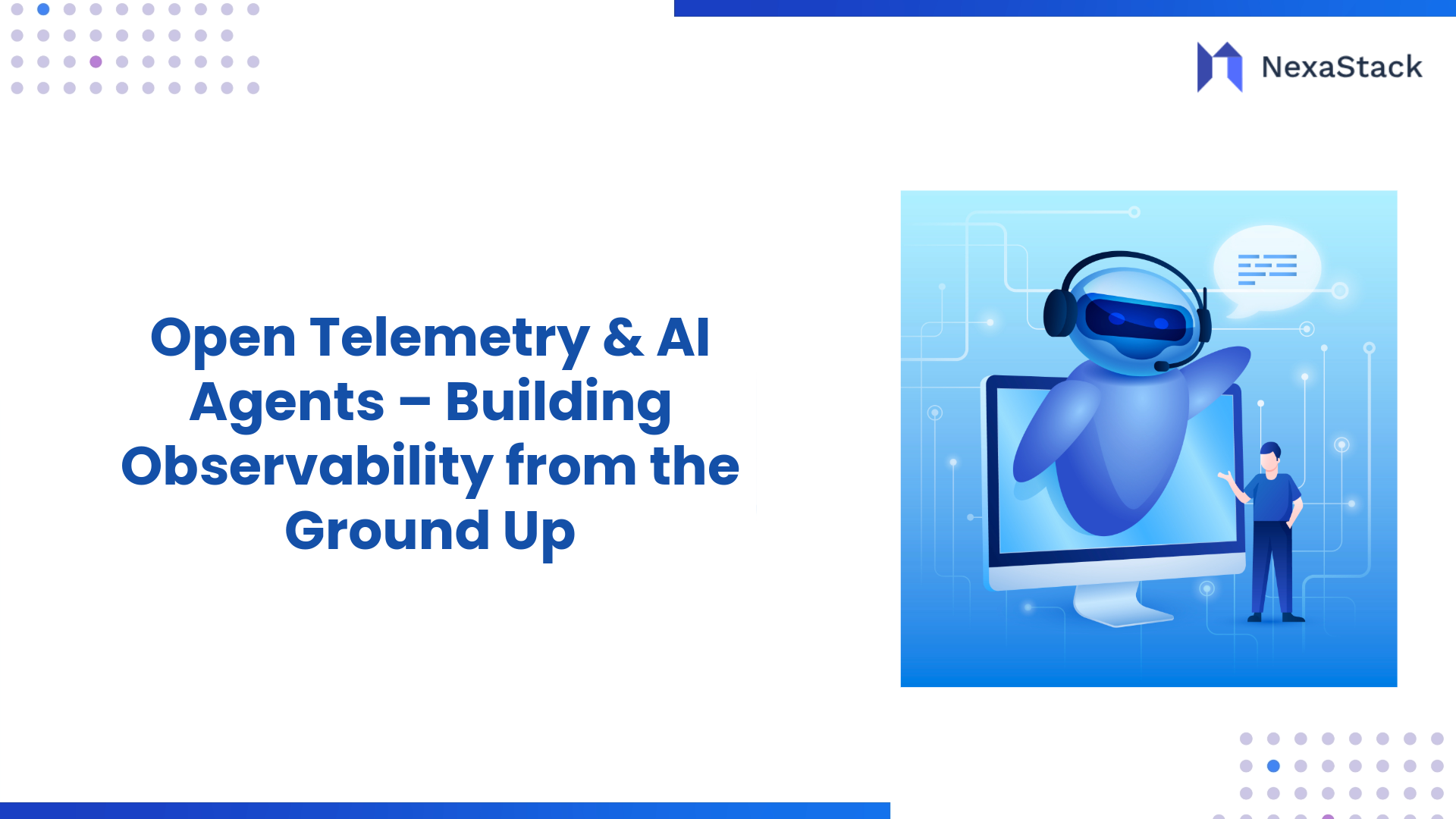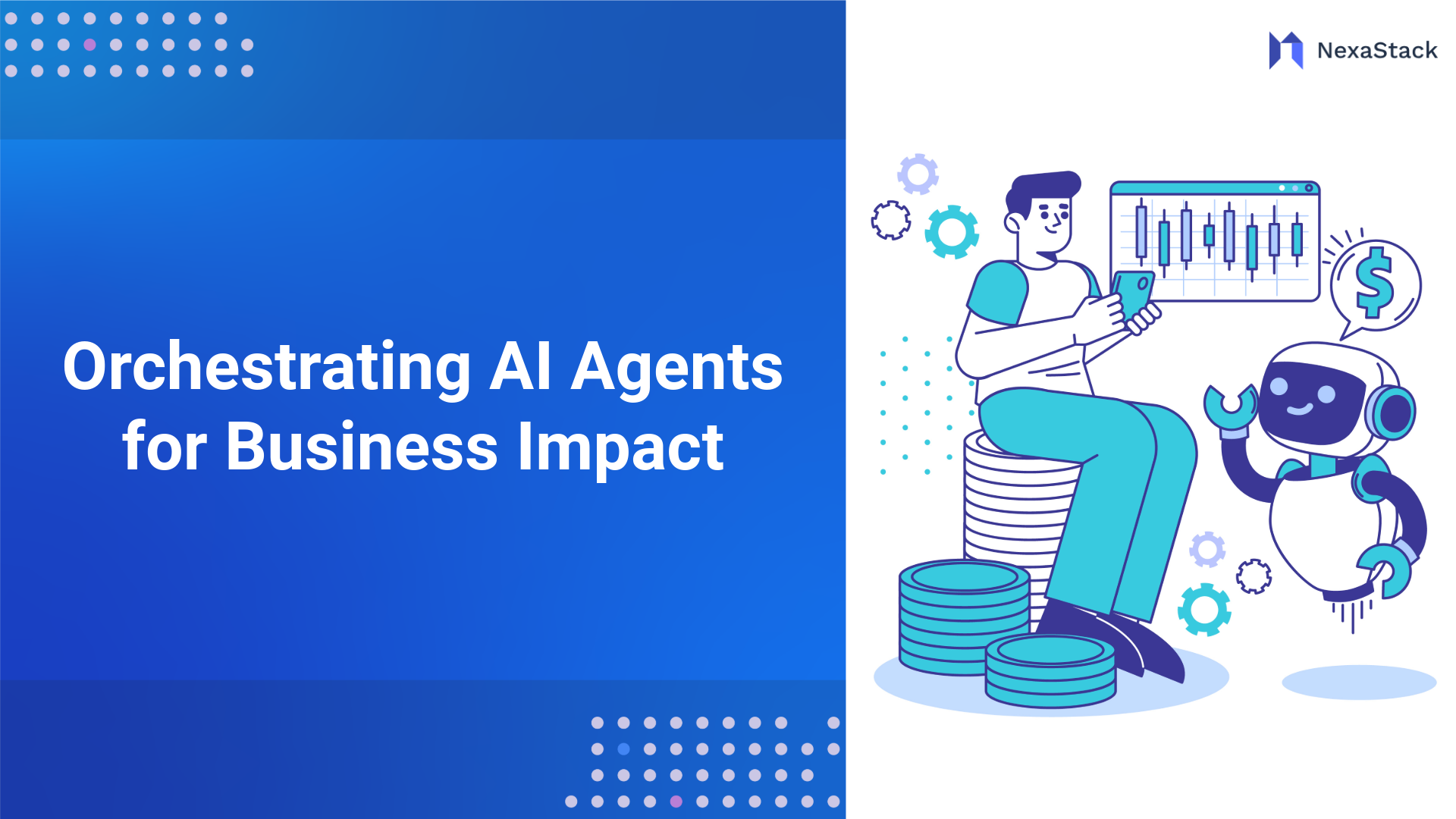RL Algorithm Types and When to Use Them
Reinforcement Learning offers diverse algorithms, each suited to different types of problems and environments. Selecting the right approach is crucial for maximizing agent performance and training efficiency.
Value-Based Algorithms
Examples: Q-Learning, Deep Q-Networks (DQN)
Value-based methods estimate the value of a particular action in a given state. These algorithms are ideal for environments with discrete action spaces and are widely used for game playing and robotic navigation tasks.
-
Best for: Discrete action spaces, model-free environments
-
NexaStack compatibility: Easily implemented using Ray RLlib or Stable Baselines3 within NexaStack’s containerized ecosystem.
Policy-Based Algorithms
Examples: REINFORCE
Policy-based methods directly optimize the agent’s policy without estimating value functions. These are well-suited for continuous action spaces and scenarios requiring stochastic policies.
-
Best for: Continuous action spaces, stochastic or highly variable environments
-
NexaStack compatibility: Seamlessly integrated with TensorFlow and PyTorch via the NexaStack SDK.
Actor-Critic Algorithms
Examples: PPO (Proximal Policy Optimization)
Actor-critic methods combine the strengths of value-based and policy-based approaches, offering stability and scalability for complex tasks. These algorithms are commonly used for large-scale, real-world applications.
-
Best for: Large-scale, complex environments requiring stable and efficient learning
-
NexaStack compatibility: Supported through OpenAI Gym, Ray RLlib, and BYOC (Bring Your Own Container) flexibility.
Seamless Integration with RL Libraries
NexaStack offers broad compatibility with leading RL frameworks and libraries. Whether you are using Stable Baselines3, Ray RLlib, or custom algorithms built in PyTorch or TensorFlow, NexaStack’s SDK and BYOC architecture ensure that you can deploy, monitor, and scale RL workloads efficiently within a secure, enterprise-grade environment.
Deploying RL Workloads on NexaStack
Effectively deploying reinforcement learning (RL) workloads requires a platform that can handle distributed training, real-time monitoring, and pipeline automation—all while ensuring enterprise-grade security and scalability. NexaStack is purpose-built for these needs, providing a seamless RL development and deployment environment.
 Fig 2. End-to-End Workflow for Deploying RL Agents with NexaStack
Fig 2. End-to-End Workflow for Deploying RL Agents with NexaStackStep-by-Step Guide to RL Deployment
1. Run Distributed Training
Leverage NexaStack’s private cloud infrastructure to launch distributed RL training jobs. The platform dynamically allocates compute resources, enabling you to scale up experiments for faster convergence and more robust model evaluation.
-
Launch containerized RL workloads using frameworks like Ray RLlib or Stable Baselines3.
-
Use BYOC (Bring Your Own Container) to integrate custom environments and algorithms.
NexaStack offers real-time dashboards and observability tools that help you:
-
Track episode rewards, agent performance, and training metrics as experiments progress.
-
Visualise policy improvements and convergence trends, making identifying bottlenecks or opportunities for further optimisation easy.
Automate the entire RL pipeline from data ingestion to model retraining using NexaStack’s agent lifecycle management features:
-
Schedule recurring training jobs and automate model evaluation.
-
Integrate with CI/CD workflows for continuous delivery of improved RL agents.
-
Ensure compliance and privacy by keeping all data and computing within secure enterprise boundaries.
Use Cases of Self-Learning Agents with NexaStack
Self-learning agents powered by reinforcement learning are transforming diverse industries by automating complex processes, optimising operations, and enabling real-time decision-making. NexaStack’s secure, AI-native platform provides the foundation for deploying these agents at scale, ensuring privacy, compliance, and operational efficiency.
Autonomous Process Automation
-
IT and Operations: NexaStack enables organisations to automate repetitive IT support and operations tasks, improving efficiency, reducing manual intervention, and faster incident resolution. AI agents can monitor systems, detect anomalies, and proactively resolve issues, freeing teams to focus on higher-value activities.
-
Business Workflows: Enterprises leverage NexaStack’s orchestration to manage end-to-end business processes, from customer service ticketing to supply chain management. Self-learning agents adapt to workflow changes, optimise resource allocation, and continuously refine automation strategies.
Financial Market Simulations
-
Trading Optimization: Financial institutions use NexaStack to deploy RL agents for real-time trading, risk management, and market simulation. These agents analyse vast market data, adapt to changing conditions, and execute trades with improved speed and accuracy, all within a secure, compliant infrastructure.
-
Fraud Detection: RL-powered agents can simulate and detect fraudulent activities by monitoring real-time transactions, identifying anomalies, and triggering alerts for further investigation.
Overcoming Challenges in RL Deployment
Deploying reinforcement learning (RL) in enterprise environments comes with unique challenges, from managing compute resources to ensuring regulatory compliance and scaling efficiently. NexaStack addresses these obstacles with an agent-first, AI-native architecture designed for secure, scalable, and observable RL operations.
Compute Resource Management
NexaStack AI uses intelligent scheduling and auto-scaling to allocate computing resources dynamically, ensuring efficient use of GPUs and CPUs. With Xenoinify AI Cost Optimisation, organisations can monitor and control resource spending, turning infrastructure into a value driver.
-
Scalability Bottlenecks
NexaStack’s agentic infrastructure, featuring SAIF Aviator, enables seamless auto-scaling of multi-agent systems across private cloud, hybrid, and edge environments. This ensures RL workloads scale effortlessly from pilot to production, maintaining compliance and data sovereignty.
-
Data Pipeline Complexity
With Agent SRE, NexaStack provides real-time observability and troubleshooting for agent behaviour. Integrated policy-as-code, LLMOps, and a unified model catalogue streamline compliance, versioning, and lifecycle management—simplifying RL deployments from experimentation to production.
Tools and Frameworks Supported by NexaStack for RL
A successful reinforcement learning (RL) deployment relies on seamless integration with industry-leading tools and frameworks. NexaStack is designed as an open, containerized, AI-native ecosystem, supporting a wide range of RL libraries and machine learning frameworks to accelerate experimentation and production.
Supported RL Libraries
-
OpenAI Gym: The de facto standard for developing and benchmarking RL algorithms, enabling rapid prototyping of custom environments.
-
Ray RLlib: A scalable RL library for distributed training, perfect for large-scale, multi-agent experiments.
-
Stable Baselines3: A popular collection of high-quality RL implementations, ideal for research and fast iteration.
NexaStack Integration Highlights
-
NexaStack SDK: Simplifies integration with custom RL models and environments, supporting both open-source and proprietary codebases.
-
Bring Your Own Container (BYOC): Deploy any RL library or framework within NexaStack’s secure, enterprise-grade infrastructure.
-
Unified Observability: Monitor, debug, and optimize RL workloads across all supported frameworks using NexaStack’s integrated dashboards and analytics.
Case Study: RL-Based Decision Optimization Using NexaStack
To illustrate Nexastack's real-world impact, let’s explore a practical case study involving RL-based decision optimization in the energy sector.
Scenario: Smart Energy Grid Optimization
A leading utility company aimed to optimize energy distribution across a smart grid by deploying reinforcement learning agents. The goals were to minimize energy loss, balance supply and demand in real time, and reduce operational costs while maintaining strict regulatory compliance.
Solution Implementation with NexaStack
-
Custom RL Environment: Using OpenAI Gym integrated within NexaStack’s secure infrastructure, the team simulated a digital twin of the energy grid, allowing agents to experiment with different distribution strategies in a risk-free environment.
-
Distributed Training: The company leveraged Ray RLlib on NexaStack’s private cloud to run large-scale, distributed RL training jobs. Auto-scaling and intelligent resource management ensured efficient compute usage and cost control.
-
Real-Time Monitoring: NexaStack’s unified observability tools enabled the team to monitor episode rewards, convergence trends, and agent performance in real time, supporting rapid iteration and troubleshooting.
-
Automated Pipelines: The deployment pipeline was automated using NexaStack’s agent lifecycle management, allowing continuous retraining and deployment of improved RL agents as new data became available.
Results and Impact
-
Operational Efficiency: The RL agents achieved a measurable reduction in energy loss and improved grid stability, resulting in significant cost savings.
-
Scalability: NexaStack’s platform allowed the utility to scale from pilot simulations to full production deployment without infrastructure bottlenecks.
-
Compliance and Security: All sensitive operational data remained within the company’s private cloud, ensuring compliance with industry regulations.
Future-Proofing Agentic AI with NexaStack
As agentic AI systems become more advanced and collaborative, organisations need platforms that can adapt and scale with future demands. NexaStack is purpose-built to support this evolution, offering a modular, composable architecture that makes it easy to integrate new technologies and deploy multi-agent systems.
With features such as auto-scaling, agent-first infrastructure, and enterprise-grade security, NexaStack ensures that your AI workloads remain secure, compliant, and efficient as your needs evolve. Its support for multi-agent collaboration and seamless integration with leading AI tools means your organisation is always ready to leverage the latest advancements in intelligent automation.
By choosing NexaStack, enterprises can confidently build and scale the next generation of adaptive, agentic AI systems—staying ahead in a rapidly evolving digital landscape.
Conclusion: Building the Next Generation of Autonomous Systems
Self-learning agents powered by reinforcement learning redefine what’s possible in automation, optimisation, and intelligent decision-making. By leveraging Nexastack's secure, scalable, and modular capabilities, organisations can confidently deploy, monitor, and scale these advanced agents across private cloud, edge, and hybrid environments. With its agent-first architecture, robust observability, and seamless integration with leading AI frameworks, NexaStack empowers enterprises to accelerate innovation, maintain compliance, and future-proof their AI infrastructure.
Frequently Asked Questions (FAQs)
Advanced FAQs on Self-Learning Agents powered by Reinforcement Learning.
How do self-learning agents optimize decisions over time?
They learn through continuous feedback loops, updating policies based on rewards from real or simulated environments.
What makes reinforcement learning suitable for autonomous agents?
It enables agents to explore actions, evaluate outcomes, and adapt strategies dynamically without predefined rules.
How do agents prevent unsafe or biased learning behaviors?
Through constrained reward functions, safety filters, and human-in-the-loop evaluation during policy updates.
Can reinforcement learning scale to multi-agent systems?
Yes — coordinated learning, shared rewards, and decentralized policies enable robust multi-agent collaboration.







